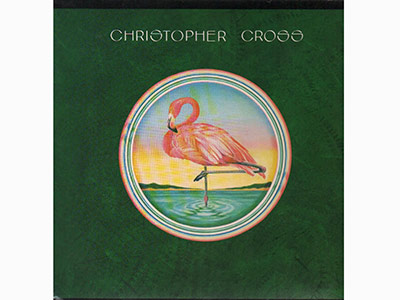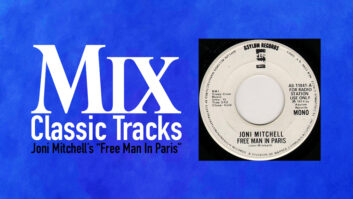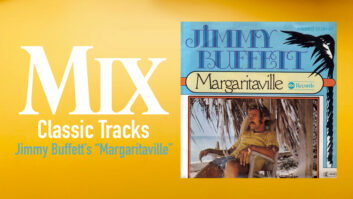
“Ride Like the Wind,” and Christopher Cross’s Grammy history-making debut album, might not have happened if Cross hadn’t discovered in time that Michael Omartian had played on Steely Dan’s records.
At the meeting when Omartian told Cross that he would be producing him, Cross was less than enthusiastic. Omartian was fairly new at Warner Bros., and he guesses in retrospect that Cross had envisioned someone like Ted Templeman or Lenny Waronker taking the reins. When Cross left his office, Omartian told his assistant he just didn’t know what to make of Cross’s reaction, and she told him to blow him off.
“About a half hour later, I hear a knock on my door,” Omartian recalls. “It’s Chris. He says, ‘Oh, man, you’re going to have to produce my record.’ I said, ‘What happened?’ He said, ‘I found out you played on all the Steely Dan stuff, and that’s all I needed to know.’”
Omartian had first encountered Cross’s music at a Wednesday morning A&R meeting, where all the Warner Bros. producers sat around a table, listened and handpicked their next projects. He says that as they got hungrier and it got closer to lunch, maybe the cassette tapes didn’t sound as good.
But that day his stomach wasn’t growling when he heard the tape Christopher Cross sent in that had “Ride Like the Wind,” “Sailing” and a couple of other tunes, and he asked the table of guys—including Templeman and Waronker—if the music moved them, because it had moved him.
“They said, ‘Well, if you want to do it, do it, because this guy’s been bugging us for two years,” Omartian recalls.
The demo was rudimentary, cut with Cross’s Austin, Texas band, and Omartian says “Ride Like the Wind” reminded him of a Western.
“I was always a guy who felt that if it sounds good in its most elemental form, then you’ve got something,” Omartian says.
For about six months they recorded in both studios A and B of Burbank’s Amigo Studios (which, after a while, became referred to as Warner Bros. Studios), where the finished product changed quite a bit from the original demo, thanks to a lot of teamwork between Omartian and Cross.
“Someone once told me, ‘Never fall in love with your own ideas.’ I’ve always kept that as my mantra,” Omartian says. “Unless it’s something that’s gotta be. But I don’t even argue. If the artist says, ‘Nah, I don’t feel it,’ I go, ‘Okay, let’s move on.’ I always work in tandem with an artist because you’re producing their record. It’s not your record.”
“Ride Like the Wind” was the first track they recorded, and Omartian says using Cross’s Austin band—Tommy Taylor on drums, Andy Salman on bass, Rob Meurer on synth—was what helped create the magic, even though it took longer for them to adjust in the studio. “These guys were tight with him,” Omartian says.
It took about two to three days to get the track to feel right, Omartian says because the band wasn’t accustomed to a studio. “They were great musicians, but a little nervous,” he says. “I remember thinking after the first day when I went home, ‘Oh my goodness, can this band do this?’” When all was said and done, Omartian says, he regrets not continuing to use the band beyond the debut album.
“As soon as the album took off, Chris got infatuated with the best studio players in town, and I remember telling him, ‘Dude, you’ve got such a sound with these guys.’ He insisted on it. It was really kind of the band sound to me, and Chet Himes, the engineer and mixer from Austin, who did a great job.”
One of the first things that dictated the song was a change in the drums. Omartian recalls that on the original demo, there was a very straight rock beat.
“As we were doing it, someone, and I don’t remember who, said, ‘Let’s just suggest 4 on the floor with the bass drum so it hit every beat,’” Omartian says. “That gave it a drive that made the thing hop from the beginning.”
Omartian was impressed with Cross’s guitar playing, too, and he received accolades for his solo on “Ride Like the Wind.” “He always wanted someone else to play a solo, and I’d say ‘no’,” Omartian says. “I’d say, ‘Dude, play the solo,’ and he’d just burn it up. After we were done with the record, Walter Becker and Donald Fagen both wanted him to play guitar on one of their records, and he was so intimidated, afraid to do it, and he never did.”
The producer says Cross was much more confident about his vocals, and justly so.
“I always like to get the vocal on pretty quickly after the basic track so you’re not loading stuff up that competes too much with the vocal,” Omartian says, adding that they used an AKG 414 on his leads: “We got the lead right away. We probably went to four or five tracks and then comped the vocal parts. Chris’s pitch was ridiculous and he was very stylized, so when you went from one thing to another, he was exactly the same. If there was an impulse to do something like a scat or some kind of a riff, he had thought about it so every single track possessed that same riff. He wrote his vocals as they were to be, period. You could depend on all five tracks to be the same. You just took the best.”
The basic tracks had gone on first, which was the basic chord line played by four instruments playing the Identical part. Cross wanted Omartian to play on the record, so Omartian played acoustic piano and Rhodes on top; Cross played guitar, and another acoustic guitar.
On the original demo, Cross sang the answer vocal, but Omartian said it really should be a different voice and suggested Michael McDonald. Omartian says that when McDonald came into the studio soon after that, Cross was like a little kid in a candy store. They recorded the answers and then harmonies in the release section.
Victor Feldman came in to do some percussion, Lenny Castro played the signature conga part, and then strings and horns were the last piece of the track.
The horns played by Lew McCreary (trombone), Jackie Kelso (saxophone), Don Roberts (saxophone) and Chuck Findley (trumpet) were voiced exactly the same as the vocals on the release section so they blended together, Omartian says.
Violinist Assa Drori was called in to head up what Omartian recalls as a 28-piece string section, and the horns and strings completed what Omartian describes as a track with everything “but the kitchen sink.”
Omartian reminds us that it was 1979 and his memory is hazy, but he recalls the console was a Harrison 48-channel board, and there were two Ampex 1200 24-track machines. “When you had those tracks available, you tended to use them,” Omartian says. “It was ’79, so the automation would have been pretty rudimentary.”
At the end, Himes and Cross had what Omartian calls a “Clint Eastwood moment” and thought of adding the wind sound near the opening of the track.
“It could have ended up being dopey, but we didn’t push the volume up on the sound effect to make it take over what was going on,” he says. “It seemed to add to the cinematic flavor of the song.”
It came from a sample, but in those days they weren’t digital. “You went to a library of sound effects and you pulled out a record or a piece of tape, and all you did was put it up where you wanted it onto the 24-track. There was no slick way of doing it. It was just trial and error.”
And at the end, what had started off as shaky in his office, resulted in a wonderful ongoing partnership between Omartian and Cross. Omartian says he learned to be patient with Cross’s analytical ways.
“Just to give you an idea, whenever you presented an idea that was new to Chris, he really needed time to think about it,” Omartian says. “When we were doing ‘Sailing,’ there was no piano solo on the demo, just some chords. It took him about four hours to warm up to the idea of the solo. I did it in one take and his band said, ‘That’s it, that’s it,’ and he said, ‘I don’t know, I don’t know.’ The night guy who cleans the studio walked in while we were in there and Chris said, ‘Would you listen to something for me?’ He listened to the solo and Chris said, ‘What do you think?’ He said, ‘I think it’s really good.’ And Chris said, ‘Okay.’”
Ultimately, the album was stalled.
“It was an era where Debbie Harry and the Cars and punk music was huge and we were in the studio making something anything but,” Omartian says. “But when you’re lost in that world, you’re not thinking about what’s going on outside until you’re ready to present it. When we were finished, the head of promotion, Russ Thyret, came down to my office and said, ‘I know you did a great job, but nobody’s playing these kind of records.’ He said, ‘I like the record, but I don’t think radio would want it, so we’re going to delay the release for six months.’”
Omartian and Cross felt disheartened, but when the record took off, Omartian got a very different call. Thyret said, “Lest you think we had anything to do with this, forget it. We just put it out and it went nuts.”







